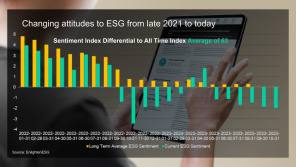

The Treasury has announced a set of green financing initiatives including its green bond and green finance framework.
The government's green savings retail product, issued via NS&I, will be tied to a sovereign green bond and will have a three-year fixed-term.
Consumers will be able to invest between £100 and £100,000 in the product, which will be issued later this year.
In a statement, the Treasury said the aim of these was to enable individuals to support green projects such as delivering infrastructure improvements and creating green jobs across the country.
The Treasury will also issue at least two green gilts this year, with issuance in the 2021-22 financial year totalling a minimum of £15bn. The aim of these issuances is to build out a green yield curve.
Finally, the Treasury has released more details on its green financing framework, which sets out which projects are eligible for the proceeds of green bonds.
The framework aligns with the International Capital Market Association's (ICMA) green bond principles.
It includes the six types of green projects that will be financed across the UK by the green gilts and retail bonds.
These include clean transportation, renewable energy, energy efficiency, pollution prevention and control, living and natural resources and climate change adaptation.
As part of the framework, the government has committed to annual allocation reporting and biennial reporting on environmental impacts and social co-benefits, to ensure transparency for investors.
The framework has been assessed by V.E. (part of Moody’s ESG solutions), who found a ‘robust’ level of assurance on the contribution of the UK’s framework to sustainable development, which the Treasury said was the same achieved by other sovereign issuers.
The Carbon Trust also reviewed the framework’s guidance on allocation of proceeds, and found they ‘align sensibly’ with the Climate Change Committee’s recommended climate targets for the UK.
Laith Khalaf, financial analyst at AJ Bell, said the success of the new NS&I bond will be determined by the interest rate on offer.
“Of course, thanks to the Bank of England’s QE programme and ultra-low interest rates, the government can borrow money extremely cheaply, currently around 0.4 per cent per annum for 5 years.
"Any premium offered by the green savings bond above prevailing gilt yields is effectively an extra burden for the taxpayer, and costs incurred in this way will naturally be weighed up against other fiscal decisions taken by the chancellor to repair the nation’s finances in the wake of the pandemic.
“Sunak is between a rock and a hard place here. If he hikes rates up for the green bond, he’ll face criticism for needlessly spending money when government borrowing is already sky high."
He added: "If the chancellor opts for fiscal prudence, it may be that the ability to save in a way that helps green causes, together with the security and brand of NS&I, is able to overcome any quibbles over the interest rates on offer.
"But with rising inflation a clear and present danger to cash returns, consumers may well be picky about the interest rate they get on their money, particularly if it’s locked away for the longer term.”
Sarah Coles, personal finance analyst at Hargreaves Lansdown, agreed the interest rate will be key to the bond’s success.
“The N&I green savings bond will let savers put their money where their mouth is, and support sustainable projects with their savings.
"But while it’s a useful addition to the growing world of green savings, there are already accounts with similar aims on offer. What really matters here is the rate, and NS&I is remaining tight-lipped on that front."
She added: “The timing may well be wrong for revealing the rate right now. Over the past few weeks, smaller banks have been competing hard at the top of the fixed rate savings tables, pushing the most competitive rates up.
"This is likely to die back as these banks fill their coffers, so NS&I may want to announce the rate at a time when it compares favourably to the best on the market.”
sally.hickey@ft.com



